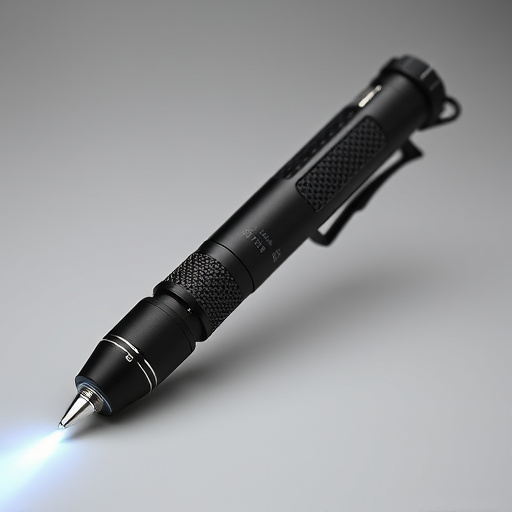Understanding the electrical current in a pen stun gun is crucial for its function and safety. The 'path of least resistance' principle disrupts muscle control by targeting conductive tissues, leading to temporary paralysis. Factors like voltage and amperage determine effectiveness. Research focuses on how distance, body composition, contact points, and environment impact current penetration, aiding law enforcement in safe and efficient use while minimizing side effects. Advanced simulation techniques, including FEA and 3D rendering, visualize current spread patterns for reliable operation.
Electrical current’s behavior is a fascinating yet critical aspect of understanding energy transfer, especially in unusual contexts like pen stun guns. This article delves into the intricate world of electrical current spread pattern analysis, offering insights that range from fundamental principles to practical applications.
We’ll explore how these patterns reveal crucial information, using the pen stun gun as a compelling case study. Additionally, we’ll introduce techniques and tools used to visualize and interpret these patterns, shedding light on the science behind this technology.
- Understanding Electrical Current and Its Behavior
- Pen Stun Gun: A Case Study for Spread Pattern Analysis
- Techniques and Tools for Visualizing and Interpreting Patterns
Understanding Electrical Current and Its Behavior
Understanding electrical current involves grasping its fundamental nature as a flow of electrons, much like water through pipes. In the context of a pen stun gun, this current serves as the driving force behind its incapacitating effect. The behavior of electrical current is influenced by various factors, including resistance, voltage, and the path it takes through a conductive material. When a pen stun gun is activated, a high-voltage, low-amperage current is discharged, designed to disrupt muscle control in the target, making it an effective non-lethal self-defense tool.
The spread pattern of this electrical current is crucial for understanding how the device works and its potential impact. The current seeks the path of least resistance, flowing through conductive tissues like muscles and nerves. This targeted delivery ensures that the current interferes with neural signals responsible for muscle contraction, leading to temporary paralysis. Analyzing this spread pattern is essential for both improving stun gun technology and ensuring safe use, as it helps professionals understand optimal deployment scenarios and potential risks associated with electrical shock.
Pen Stun Gun: A Case Study for Spread Pattern Analysis
A pen stun gun, also known as a taser, offers an intriguing case study for analyzing the spread pattern of electrical current. When activated, these devices emit a stream of charged particles designed to temporarily incapacitate a target by disrupting muscle control. The specific path and intensity of this current flow are critical factors in understanding both the effectiveness and potential risks associated with stun guns. By studying how the electrical current spreads from the device to the target, researchers can gain insights into the optimal deployment strategies for maximum impact while minimizing collateral damage.
This analysis involves examining various factors such as the distance between the stun gun and the target, body composition, contact points, and environmental conditions. Each variable influences how quickly and deeply the current penetrates the body, affecting both the stun’s efficiency and potential side effects. Understanding these patterns is crucial for law enforcement and security professionals who rely on pen stun guns as a non-lethal force option, ensuring their safe and effective use in real-world scenarios.
Techniques and Tools for Visualizing and Interpreting Patterns
Visualizing and interpreting electrical current spread patterns is a crucial step in understanding how energy flows through various materials, especially when analyzing devices like pen stun guns. Techniques such as computer simulations and specialized software play a significant role in this process. These tools enable researchers to model complex scenarios, predict current behavior, and gain insights into the underlying physics. By simulating different conditions, from varying material properties to geometric configurations, scientists can identify optimal designs and troubleshoot potential issues before physical prototypes are built.
One powerful method is finite element analysis (FEA), which breaks down a system into smaller, manageable elements to calculate electric fields and currents accurately. This approach is particularly useful for pen stun guns, where understanding current distribution within the device is essential for safety and performance. Advanced visualization tools, like 3D rendering software, allow for the creation of detailed graphical representations of these patterns, making it easier to identify hotspots, potential arcing points, or areas of uneven current density—all critical factors in ensuring the reliable and safe operation of such devices.
Electrical current spread pattern analysis is a crucial tool for understanding how energy flows through various materials, especially in real-world applications like pen stun guns. By studying these patterns, researchers and engineers can optimize design, enhance performance, and ensure safety. Techniques such as advanced visualization tools enable precise interpretation of current flow, leading to innovative solutions in electronics and beyond. The case study on pen stun guns highlights the practical importance of this analysis, demonstrating its potential to improve device effectiveness and user safety.
